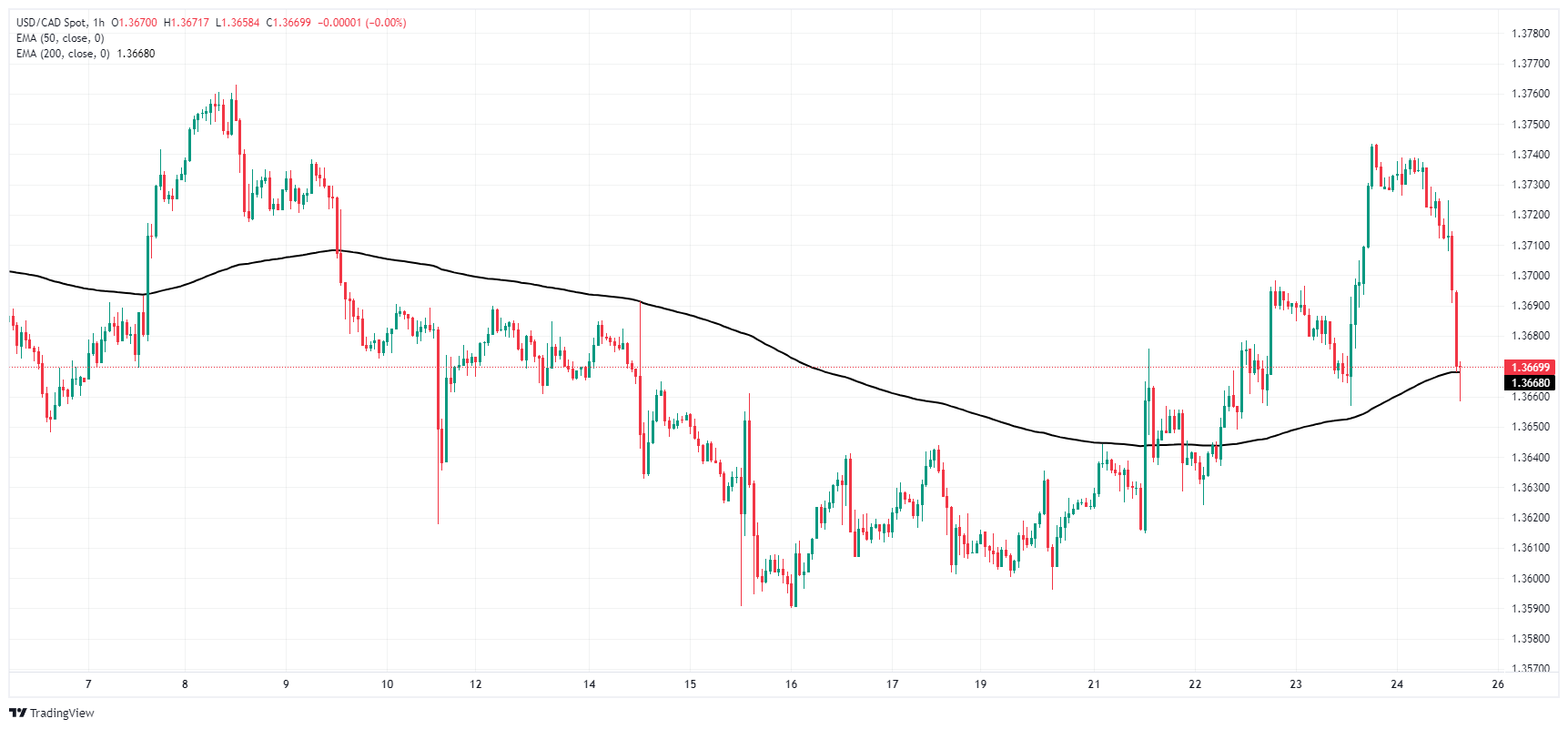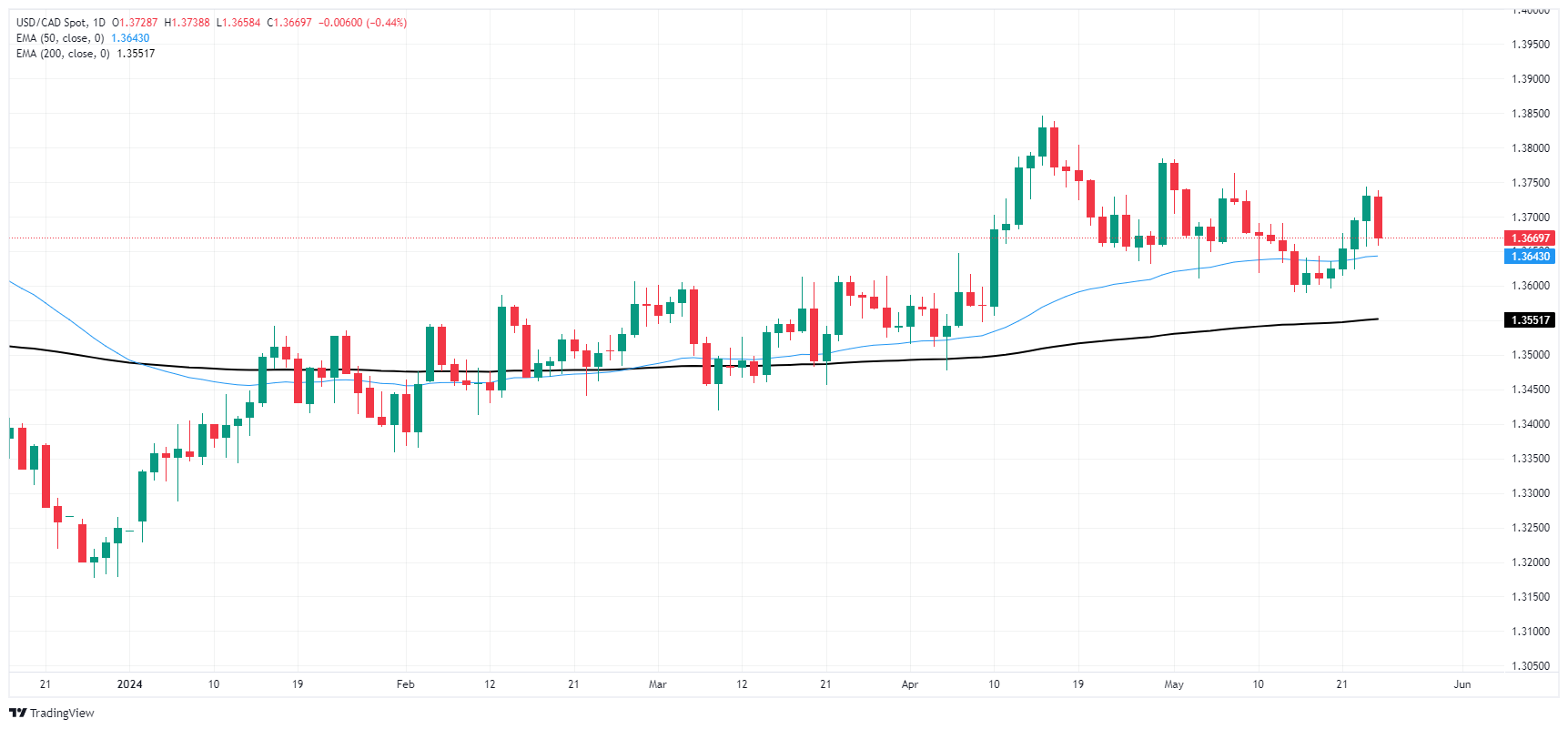Canadian Dollar rebounds on Friday despite downturn in Canadian Retail Sales
- Canadian Dollar recovers lost ground but remains down for the week.
- Canada Retail Sales decline further, limiting CAD recovery.
- Broad market risk appetite recovers after US inflation expectations ease.
The Canadian Dollar (CAD) recovered ground on Friday, sparked by a shift in investor risk appetite. US Durable Goods Orders snubbed an expected decline, and Consumer 5-year Inflation Expectations in May eased slightly.
Canada saw a fresh downturn in Retail Sales in March after median forecasts expected a slight bounce. Despite further signs of economic weakness in Canada, broader market sentiment gained ground and forced the US Dollar (USD) lower after the Michigan Consumer Sentiment Index climbed higher than expected in May.
Daily digest market movers: Market sentiment rebounds, Canadian Dollar shrugs off Canadian data miss
- Canadian Retail Sales slid -0.2% MoM in March, missing the forecasted recovery to 0.0% from the previous month’s -0.1%.Canadian Retail Sales excluding Automobiles tumbled to a nine-month low of -0.6% MoM, entirely missing the forecast of 0.1%, though the previous month’s figure was revised upward slightly to -0.2% from -0.3%.
- US Durable Goods Orders in April rose 0.7%, shrugging off the -0.8% forecast, though the previous month’s print was steeply revised lower to 0.8% from 2.6%.
- The University of Michigan’s Consumer Sentiment Index printed firmly higher at 69.1 compared to the previous month’s 67.4. Median market forecasts had expected a slight uptick to 67.5.
- The UoM 5-year Consumer Inflation Expectations in May eased to 3.0% versus the expected hold at 3.1%.
- Market sentiment is recovering on Friday after a midweek spike in risk aversion sparked by a harsh rebalancing of investor rate cut expectations. The CME’s FedWatch Tool shows that rate markets are pricing in nearly-even odds of a rate cut from the Federal Reserve (Fed) in September, down sharply from 70% at the beginning of the week.
Canadian Dollar PRICE This week
The table below shows the percentage change of Canadian Dollar (CAD) against listed major currencies this week. Canadian Dollar was the strongest against the Australian Dollar.
| USD | EUR | GBP | JPY | CAD | AUD | NZD | CHF | |
|---|---|---|---|---|---|---|---|---|
| USD | 0.18% | -0.31% | 0.85% | 0.36% | 1.03% | 0.27% | 0.58% | |
| EUR | -0.18% | -0.52% | 0.73% | 0.19% | 0.89% | 0.10% | 0.41% | |
| GBP | 0.31% | 0.52% | 1.10% | 0.73% | 1.40% | 0.62% | 0.92% | |
| JPY | -0.85% | -0.73% | -1.10% | -0.49% | 0.19% | -0.55% | -0.26% | |
| CAD | -0.36% | -0.19% | -0.73% | 0.49% | 0.62% | -0.09% | 0.21% | |
| AUD | -1.03% | -0.89% | -1.40% | -0.19% | -0.62% | -0.79% | -0.48% | |
| NZD | -0.27% | -0.10% | -0.62% | 0.55% | 0.09% | 0.79% | 0.30% | |
| CHF | -0.58% | -0.41% | -0.92% | 0.26% | -0.21% | 0.48% | -0.30% |
The heat map shows percentage changes of major currencies against each other. The base currency is picked from the left column, while the quote currency is picked from the top row. For example, if you pick the Canadian Dollar from the left column and move along the horizontal line to the US Dollar, the percentage change displayed in the box will represent CAD (base)/USD (quote).
Technical analysis: Canadian Dollar pulls back from bearish edge but is still broadly lower for the week
The Canadian Dollar (CAD) pared some of the week’s losses on Friday, but still remains firmly lower against most of its major currency peers compared to Monday’s opening bids. The Canadian Dollar extended gains to two-thirds of a percent against the Australian Dollar (AUD) this week, while holding a third of a percent higher against the Japanese Yen through the week.
Despite a firm Friday rebound, the CAD remains down four-tenths of one percent against the Greenback as the US Dollar remains one of the week’s strongest performers. USD/CAD pulled back to 1.3670 during Friday’s US market session, dipping from the week’s highs near 1.3745. However, the pair still remains higher on the week, trading on the high side of a technical bounce from the 1.3600 handle.
Choppy chart conditions hold USD/CAD near the 200-hour Exponential Moving Average (EMA) near 1.3668. Further bearish momentum will find a firm price floor at the 200-day EMA at 1.3553.
USD/CAD hourly chart
USD/CAD daily chart
Canadian Dollar FAQs
The key factors driving the Canadian Dollar (CAD) are the level of interest rates set by the Bank of Canada (BoC), the price of Oil, Canada’s largest export, the health of its economy, inflation and the Trade Balance, which is the difference between the value of Canada’s exports versus its imports. Other factors include market sentiment – whether investors are taking on more risky assets (risk-on) or seeking safe-havens (risk-off) – with risk-on being CAD-positive. As its largest trading partner, the health of the US economy is also a key factor influencing the Canadian Dollar.
The Bank of Canada (BoC) has a significant influence on the Canadian Dollar by setting the level of interest rates that banks can lend to one another. This influences the level of interest rates for everyone. The main goal of the BoC is to maintain inflation at 1-3% by adjusting interest rates up or down. Relatively higher interest rates tend to be positive for the CAD. The Bank of Canada can also use quantitative easing and tightening to influence credit conditions, with the former CAD-negative and the latter CAD-positive.
The price of Oil is a key factor impacting the value of the Canadian Dollar. Petroleum is Canada’s biggest export, so Oil price tends to have an immediate impact on the CAD value. Generally, if Oil price rises CAD also goes up, as aggregate demand for the currency increases. The opposite is the case if the price of Oil falls. Higher Oil prices also tend to result in a greater likelihood of a positive Trade Balance, which is also supportive of the CAD.
While inflation had always traditionally been thought of as a negative factor for a currency since it lowers the value of money, the opposite has actually been the case in modern times with the relaxation of cross-border capital controls. Higher inflation tends to lead central banks to put up interest rates which attracts more capital inflows from global investors seeking a lucrative place to keep their money. This increases demand for the local currency, which in Canada’s case is the Canadian Dollar.
Macroeconomic data releases gauge the health of the economy and can have an impact on the Canadian Dollar. Indicators such as GDP, Manufacturing and Services PMIs, employment, and consumer sentiment surveys can all influence the direction of the CAD. A strong economy is good for the Canadian Dollar. Not only does it attract more foreign investment but it may encourage the Bank of Canada to put up interest rates, leading to a stronger currency. If economic data is weak, however, the CAD is likely to fall.

